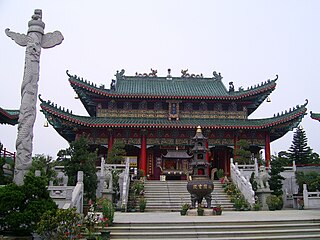
Tuen Mun District is one of the 18 administrative districts of Hong Kong. It is the westernmost continental district of Hong Kong. It had a population of 487,546 in 2011. Part of the district is the Tuen Mun New Town, which contains one of the largest residential areas in the New Territories.

Tsing Yi, sometimes referred to as Tsing Yi Island, is an island in the urban area of Hong Kong, to the northwest of Hong Kong Island and south of Tsuen Wan. With an area of 10.69 km2 (4.13 sq mi), the island has extended drastically by reclamation along almost all its natural shore and the annexation of Nga Ying Chau (牙鷹洲) and Chau Tsai. Three major bays or harbours, Tsing Yi Lagoon, Mun Tsai Tong and Tsing Yi Bay (青衣灣) in the northeast, have been completely reclaimed for new towns.

Wong Tai Sin Temple is a well known shrine and tourist attraction in Hong Kong. It is dedicated to Wong Tai Sin, or the Great Immortal Wong. The 18,000 m2 (190,000 sq ft) Taoist temple is famed for the many prayers answered: "What you request is what you get" (有求必應) via a practice called kau chim. The temple is located on the southern side of Lion Rock in the north of Kowloon.

Hong Kong counts approximately 600 temples, shrines and monasteries. While Buddhism and Christianity are the most widely practiced religions, most religions are represented in the Special Administrative Region.

The Tung Wah Group of Hospitals, with a history dating back to 1870, is the oldest and largest charitable organisation in Hong Kong. It provides extensive education and community services through 194 service centres spread across Hong Kong.

Tai Wai is an area in the New Territories, Hong Kong, located between Sha Tin and the Lion Rock, within the Sha Tin District.
Religion in Hong Kong is characterized by a multi-faith diversity of beliefs and practices.

Tuen Mun or Castle Peak is an area near the mouth of Tuen Mun River and Castle Peak Bay in the New Territories, Hong Kong. It was one of the earliest settlements in what is now Hong Kong and can be dated to the Neolithic period. In the more recent past, it was home to many Tanka fishermen who gathered at Castle Peak Bay. Tuen Mun is now a modern, mainly residential area in the north-west New Territories. As of 2011, 487,546 live in Tuen Mun and over 95% of them are Chinese.
Articles related to Hong Kong include:

Taoism in Hong Kong is the religion of approximately 14% of the population. This figure did not include the large number of local population who are following Chinese folk religious traditions without indicating their religious affiliation.
A Taoist temple (traditional Chinese: 觀; simplified Chinese: 观; pinyin: guàn, also called 道观 dàoguàn and 宫观, is a place where the Tao is observed and cultivated it is a place of worship in Taoism.

Fung Ying Seen Koon was founded in 1929 as an affiliate of the Quanzhen Longmen Lineage (全真龍門派) of Taoism. FYSK is a superb example of Taoist design and craftsmanship. It was named after the two fairy islands of Fung Lai and Ying Chau of the Bohai Sea. It Dominates the skyline from its commanding site on a hillside overlooking the New Territories town of Fanling in Hong Kong. Its massive orange-tiled double roof, built to traditional design and supported by stout red pillars of stone, catches the eyes immediately, inviting the visitor to step up to its entrance and inspect the many examples of artistic craftsmanship to be found within its grounds.
Ching Chung may refer to:










